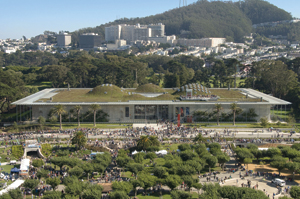J. Patrick Kociolek, the lauded visionary behind the super-green reinvention of the California Academy of Sciences in San Francisco’s Golden Gate Park, doesn’t let grass grow under his feet, at least not for long. In mid- 2007, before the sod was installed on the hilly planted roof of the $488- million natural history museum, Kociolek requested a new assignment. Having been the institution’s executive director for a decade—and the key person leading the development of the new facility instead of simply a seismic retrofit—he wanted to return to his research scientist roots.

Kociolek, a diatom geek, joined the academy out of graduate school in 1989 to fill the world’s only endowed chair for the study of the microscopic aquatic plant. He is fascinated by the diatom’s ability to dissolve glass out of water and turn it into a hard cell wall with holes. “They make a great filter,” he says.
But Kociolek got distracted from diatoms after the area’s September 1989 Loma Prieta earthquake. The original academy complex took a hit in the quake and needed a seismic upgrade. In the next several years, Kociolek reluctantly moved up the academy’s administrative ladder, and he hit the top spot in 1998. By that time, attendance was down and the museum had lost much of its luster. And it still needed a seismic retrofit. But Kociolek knew a retrofit alone wouldn’t solve the institution’s problems. He saw the opportunity to reinvent and revitalize the landmark. He asked the board of directors: “What’s a natural history museum in the 20th Century?”

Former executive director of San Francisco’s California Academy of Sciences envisioned and led the museum’s “sustainable’ reinvention.
The rest is history. The new academy, designed by Renzo Piano, opened on time and on its [revised] $256-million budget. It has a rain forest, an aquarium, a planetarium and a 2.5-acre planted roof with seven hills and 1.7-million native plants. Attendance since the Sept. 27 opening has totaled almost 550,000, compared to 140,000 for the same period in 2003. Membership has quadrupled to 80,000.
“Patrick brought this project’s possibilities to life through his intelligence, passion, courage and curiosity,” says Laura Lazarus, a board member. “Patrick’s ability to articulate [the institution’s] vision while negotiating between often competing requirements was exceptional in the extreme,” adds San Francisco-based Don Young, the academy’s project manager and owner’s representative.
Last February, Kociolek left to direct the much smaller University of Colorado Museum of Natural History, in Boulder. He is planning to reinvent that facility by leveraging the school’s many resources. Experience has shown that If anyone can recharge a museum, Kociolek can.


Post a comment to this article
Report Abusive Comment